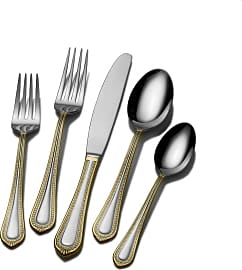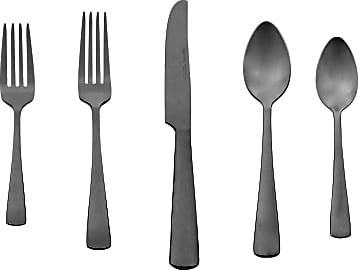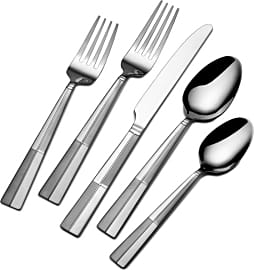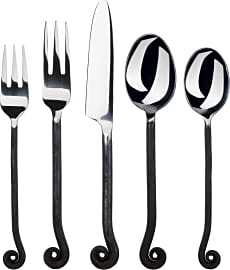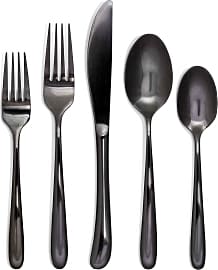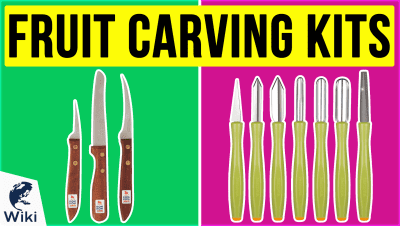The 10 Best Flatware

This wiki has been updated 41 times since it was first published in March of 2015. We're not saying you have to make a huge investment in silverware, but we have made it easier for you to upgrade from that cheap, flimsy set you've been using since college. Add a touch of elegance to your next dinner party with something from our selection of the best flatware, or just use them to class up your microwaved mac and cheese. Either way, there are sets for households of all sizes. When users buy our independently chosen editorial recommendations, we may earn commissions to help fund the Wiki.
Editor's Notes
December 10, 2019:
Unless you’re seriously embracing the minimalism trend, it’s wise to invest in kitchen utensils that aren’t just functional, but fashionable. That's especially true if you happen to enjoy entertaining. In creating this list, we've tried to include sets that will appeal to a range of aesthetic preferences. There are sleek, simple sets that allow your other dining accessories to shine, in addition to flashier options that have eye-catching details like 24 karat gold plating and ornate embellishments. These sets come in statement-making colors too, like gold and black, for those who desire something edgier than usual. What's more, all of the collections in this list are dishwasher-safe so you won't have to worry too much about longterm maintenance.
You'll also notice that several of the sets featured here come with matching serving utensils, which make them well suited to large families and holiday gatherings. To complete your kitchenware collection, you'll also need a dependable dinnerware set.
The Craft & Kin Heirloom and Mikasa Regent have been added to the list. The Towle Living Wave and Gorham Biscayne got the ax, the former due to confirmed quality complaints that called into question their ability to stand up to daily use over time, and the latter simply because trends are constantly changing and there are more stylish options on the market now than ever before.
Special Honors
Golden Michelangelo Sure, this baroque-inspired collection is jaw-droppingly expensive, but only the best for your guests, right? Each gilded fork, knife, and spoon in this set was designed by artisans in 1965, and it's no wonder these iconic utensils have remained popular for so long. It comes with a lifetime warranty. oneida.com
Eslinger Service for 4 If you're into over-the-top designs but are particular about colors, this may be the set for you. Each utensil has eye-catching silver-tone accents, and you can choose the handle color that best suits your style: black, blue, red, copper, orange, cranberry, or graphite. And it's quite affordably priced. wayfair.com
Laguiole Ivory 20-Piece This classy-looking set comes from a company revered for its steak knives, so you know quality won't be an issue here. The handles are ergonomically shaped so you can enjoy your meal in comfort and style. They're made in France, too. crateandbarrel.com
History Of The Spoon
It is probable that spoons are the oldest of man's eating utensils.
It is probable that spoons are the oldest of man's eating utensils. This stems from the fact that forks and knives must be fashioned in some manner, whereas spoons of some form or another can be found in nature. Items such as seashells and certain shaped stones are examples of natural spoons that can be used without having to be first worked in some manner.
The earliest natural and man made spoons didn't have handles, but even handled versions are significantly older than forks and knives designed for table use. Archeological evidence points to handled spoons being used in Egyptian religious ceremonies as far back as 1000 BCE. At the time, handles were most likely made from bone, slate, wood, or ivory depending on the intended application of the spoon. Wood was the most common handle material in spoons designed for food consumption.
In the Greek empire, some time around the 4th or 5th century BCE, spoons with handles made of bronze or silver starting appearing. These handle materials become more commonplace among the wealthy that bone or slate and stayed that way through the Middle Ages. In England, the first evidence of spoons comes from 1259, when they were counted as inventory in King Edward I's wardrobe. In the Middle Ages, spoons were often used in ornate ceremonies, such as the coronation of British kings and christenings.
The form of spoons changed over time before taking the modern form as we know them today some time in the 18th century.
History Of The Knife
Knives have been used as weapons and eating tools since prehistoric times, but knives specifically designed for table use came much later. The 1600s marked the beginning of the Bourbon Dynasty in France and was also the time that knives became domesticated as the eating utensils we known today.
During this time, sharp knives at the table were replaced by the rounded, blunt knives we often use today, unless eating steak.
Before this time, most knives were as sharp as possible because of their dual purpose as weapons. This made them a threat at tables both to others and oneself. This was also a time period when alcoholic beverages, such as wine and ale, were the primary forms of hydration. It was not uncommon for someone to cause a serious injury to themselves by being overly inebriated and stabbing a sharp and pointy knife into their mouth while eating. Over inebriation also caused numerous unprovoked altercations.
As forks started to gain in popularity during the Middle Ages, sharp knives were actually outlawed at the table by King Louis XIV in 1669. During this time, sharp knives at the table were replaced by the rounded, blunt knives we often use today, unless eating steak.
Asian cultures moved away from the overly sharp weapon-like knives at the table much earlier than western societies. It is believed this happened for two reasons. In 400 CE China there was a severe shortage of resources. To save on fuel, they began to chop their food into small pieces before cooking so it could be cooked quicker. This meant knives were no longer needed at the table.
There is also a famous saying by Confucius, which is believed to have also influenced the Asian culture of not using knives at the dinner table even when resources became plentiful again. He said, "The honourable and upright man keeps well away from both the slaughterhouse and the kitchen. And he allows no knives on his table." He was a vegetarian and believed sharp weapons at the table reminded eaters of the slaughter of animals. He also believed they evoked a sense of warfare.
History Of The Fork
Forks have been used in cooking applications since ancient times, but for a long time they were not utilized as table flatware. The earliest archeological evidence of forks at the table points to Ancient Egypt. There is also some evidence of their use by the people of the Qijia culture, which was around from 2400 to 1900 BCE.
This created a negative stigma that was attached to forks for a long period after her death.
The earliest known evidence of forks in western cultures comes from Venice in the 11th century. There is a story from a prominent wedding of the time that says Theodora Anna Doukaina, a Byzantine princess, brought golden forks as part of her dowry when she wed Domenico Selvo, who was the 31st Doge of Venice. What started as an innocent gift actually turned into a scandal as the Venetians saw them as a slight against God. St. Peter Damian, a Benedictine monk of the time is quoted as saying "God in his wisdom has provided man with natural forks – his fingers. Therefore it is an insult to Him to substitute artificial metallic forks for them when eating."
The princess actually died of a mysterious disease just a couple of years after the wedding and it was believed at the time that this was because of her vanity and pride, which illustrated by her use of forks instead of fingers for eating. This created a negative stigma that was attached to forks for a long period after her death.
In the 16th century, forks finally began to see some measure of popularity as an eating utensil. Catherine de Medici, an Italian noblewoman of the time and popular trend setter, used forks regularly when dining. After her marriage to King Henry II of France, the use of forks for dining began to proliferate French tables, though it was still generally a habit practiced solely by the upper class.
Over time, as the concepts surrounding hygiene changed, more and more people switched to using forks instead of eating with their hands. By the 1700s, forks had become commonplace among the elite and many carried their own private flatware set. In the first Industrial Revolution the use of forks finally spread to the middle and lower classes.



